Taking care of everyday tasks may be draining, particularly when juggling life, job, and all of the other things. A hassle-free option to get fresh milk delivered right to your door is provided by milk delivery apps, which step in to help.
If you're wondering how to create a milk delivery app, you're stepping into a high-demand market that perfectly aligns with today’s need for quality and convenience. It’s an ideal solution for busy lifestyles craving effortless essentials!
As people's habits become faster, they are looking for ways to streamline chores, and milk delivery apps provide the ideal answer.
These apps cater to the growing demand for on-demand services, allowing customers to order fresh milk and deliver it straight to their homes, saving time and effort.
If you’re thinking about starting a milk delivery business, developing a specific app is a smart move. It can help you reach more people and boost income.
To get started, check out our complete guide to milk delivery app development, packed with everything you need to know.
Milk Delivery App Market At a Glance
The milk delivery app market is fast growing, driven by changing customer preferences for ease and on-demand services. Here’s a look at the latest data showing the growth and spread of the milk delivery app market in 2024.
These figures show the enormous possibilities for businesses and startups eager to join this booming sector:
-
- Global Reach of Milk Delivery Apps: Over 1.2 billion people globally regularly use on-demand shopping and milk delivery apps, showing a 25% year-over-year rise.
- User Growth in Emerging Markets: Milk delivery app usage in areas like Southeast Asia, Africa, and Latin America has risen by 21% this year, driven by cheap mobile data and higher smartphone adoption.
- Daily Active Interaction: Users spend an average of 40 minutes daily on milk delivery apps, with platforms like Milkbasket and DailyNinja top involvement.
- Revenue Potential: The Milk Delivery Service Market Industry is expected to grow from $20.59 Billion in 2024 to $48.2 billion by 2032.
- Rise of Subscription Models: Subscription-based milk delivery apps have seen a 35% rise in income, suggesting a rising customer desire for regular, hassle-free orders.
- Provider Base Growth: The number of active milk delivery providers on these platforms has grown by 45%, showing the growing acceptance of this business model by local farms and farmers.
These data show the current market potential, outlining key possibilities for building and growing milk delivery apps.
What is a Milk Delivery App?
A milk delivery app is a digital tool that allows users to order fresh milk and have it delivered directly to their homes. These apps provide a handy answer for households, companies, and people who want to avoid running out of milk or make the process of getting milk more hassle-free.
Typically, these apps offer features like subscription-based orders, real-time tracking, and adjustable delivery plans so that customers can receive fresh milk daily, weekly, or on demand.
Some milk delivery apps also provide choices for other dairy products and shopping items, making them a one-stop shop for essential home needs.
By using a milk delivery app, users save time and effort while ensuring they always have fresh milk available, making it an ideal service for busy individuals and families.
How Do Milk Delivery Apps Work?
Milk delivery apps work by providing users with a handy and efficient way to order milk and other dairy goods straight to their homes.
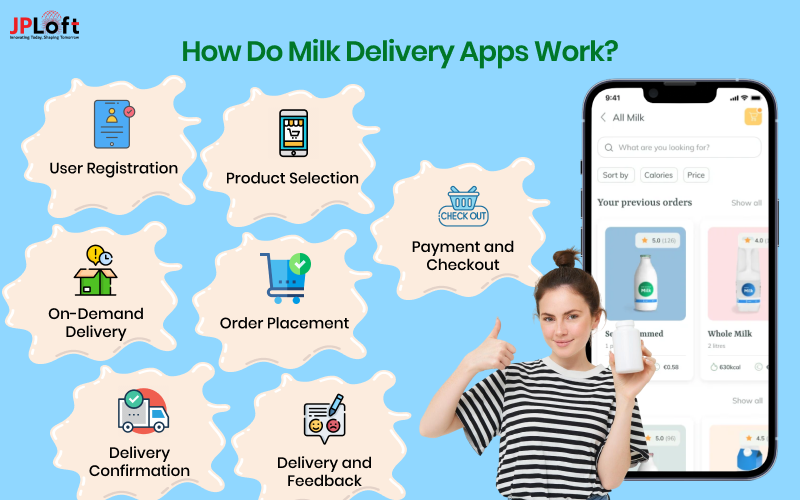
Here’s a breakdown of how milk delivery apps work:
-
- User Registration and Profile Setup: Users start by getting the app and making an account, where they can enter their delivery address, payment information, and preferences.
- Product Selection: Once logged in, users can view the available milk goods (e.g., normal, organic, lactose-free, plant-based) and other linked dairy items, such as cheese, butter, or yogurt.
- Subscription or On-Demand Delivery: Customers can choose a membership plan, where milk is delivered regularly (daily, weekly, etc.), or opt for on-demand delivery, where they request milk whenever needed.
- Order Placement: After choosing their chosen goods and delivery regularity, users place their order. They can adjust their order based on the amount, type of milk, and delivery plan.
- Payment and Checkout: The app safely processes the payment, either through credit/debit cards, mobile wallets, or other payment ways.
- Delivery Confirmation and Tracking: After the order is made, users receive proof and an expected delivery time. Many apps offer real-time tracking so users can watch the state of their delivery.
- Delivery and Feedback: Once the milk is delivered, buyers can rate the service, giving feedback on the quality and speed of the delivery.
Milk delivery apps ease the process by handling orders, ensuring fresh products, providing a smooth experience, and offering freedom in delivery options.
If you're curious about how to develop a milk delivery app, focus on features that accommodate both regular contracts and quick one-time orders. These apps effortlessly meet the needs of busy people and families.
Types of Milk Delivery Apps
Milk delivery apps come in various forms, each made to cater to specific customer wants and business models. Understanding these different types is crucial when designing a milk delivery app to ensure it fits the target crowd and offers the best possible service.
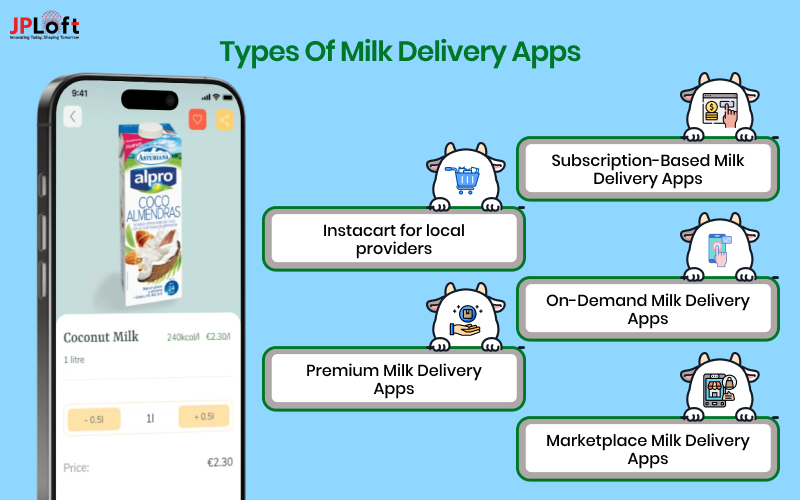
Here's a list of the primary types of milk delivery apps:
1. Subscription-Based Milk Delivery Apps
These apps enable customers to set up regular milk delivery, guaranteeing they never run out. Customers may choose the frequency of delivery and tailor their order.
Examples: Milkbasket and Daily Ninja.
2. On-Demand Milk Delivery Apps
These methods provide quick milk delivery, which is great for those who want fresh milk on short notice. Customers may order delivery anytime they need it, thanks to the on-demand milk delivery app development.
This feature allows users to enjoy the ease of having milk delivered to their doorstep exactly when they need it, making it an essential service for busy homes.
Examples: Grofers and Bigbasket,
3. Marketplace Milk Delivery Apps
These combine e-commerce with delivery services, enabling customers to buy milk alongside other dairy products and groceries and have it delivered all at once.
Examples: Amazon Fresh, Instacart
4. Instacart for local providers
These apps link clients with local dairy farms or suppliers, allowing them to have fresh milk delivered to their homes.
Examples: Farm fresh and local milk.
5. Premium Milk Delivery Apps
These platforms provide premium or specialized milk products, such as organic, lactose-free, or plant-based milk, giving health-conscious customers a more personalized experience.
Examples: The Organic Milk Company and Pure Dairy.
Each form of milk delivery app serves a unique function, providing solutions adapted to certain customer demands.
Understanding these categories will help you navigate the development process and guarantee that your app stands out in a competitive market.
By knowing what features and functionalities to include, you can develop a milk delivery app that meets customer needs and delivers exceptional value.
Best Milk Delivery Apps
When you want to create a milk delivery app, analyzing other apps on the market might provide significant insights into what sets them apart.
Understanding the features and services that distinguish successful apps will allow you to create an app that actually meets the demands of your consumers.
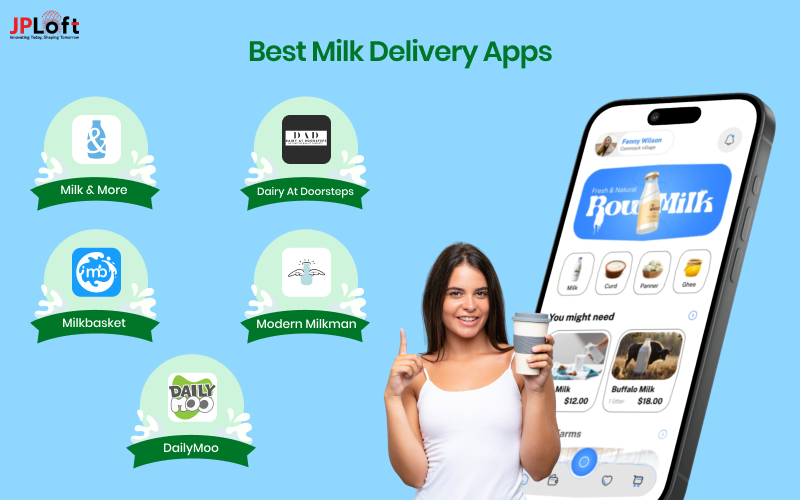
Here are some of the top milk delivery apps that have shown to be both convenient and valuable to their customers.
1. Milk & More
Milk & More is a well-known milk delivery service that brings fresh milk and a wide range of other needs right to your home.
Features:
-
- Flexible Delivery: Offers daily, weekly, or custom delivery schedules.
- Wide Range of Products: Along with milk, the app provides groceries, eggs, bread, and more.
- Sustainability Focus: Eco-friendly packaging for a greener option.
- Easy Subscription: Users can subscribe to receive regular deliveries, ensuring no need for reordering.
Key Takeaways: Milk & More’s mix of freedom, wide product range, and sustainability makes it a safe choice for customers.
2. Dairy At Doorsteps
Dairy At Doorsteps brings fresh milk from local dairy farms straight to customers' homes.
Features:
-
- Local Freshness: Delivers locally sourced fresh milk.
- Custom Orders: Allows users to select the type of milk they prefer (cow, buffalo, etc.).
- Timely Deliveries: The app focuses on punctual deliveries, ensuring fresh milk every time.
- Subscription Service: Users can opt for daily or weekly deliveries.
- Key Takeaways: Dairy At Doorstep's emphasis on fresh, local milk and its easy subscription service makes it a standout in the market.
3. Milkbasket
Milkbasket app is known for offering high-quality milk and dairy goods straight to customers' doorsteps.
Features:
-
- High-Quality Products: Delivers premium quality milk and dairy items.
- Subscription Plans: Offers weekly or monthly subscription services.
- Real-Time Tracking: Users can track their deliveries in real-time for convenience.
- Customer Support: Dedicated support for any service-related queries.
Key Takeaways: Milkbasket’s focus on expensive goods and reliable tracking makes it a go-to for quality-conscious customers.
4. Modern Milkman
Modern Milkman provides fresh milk and other groceries delivered to your house with a focus on eliminating plastic waste.
Features:
-
- Eco-Friendly Packaging: The app uses reusable glass bottles for milk delivery.
- Wide Product Range: Along with milk, it offers bread, eggs, and organic products.
- Subscription-Based: Offers subscription models for regular deliveries.
- Convenient Delivery Times: Flexible delivery times to suit customers' schedules.
Key Takeaways: Modern Milkman's eco-friendly approach and subscription service make it an excellent choice for environmentally conscientious customers.
5. DailyMoo
DailyMoo delivery app provides fresh, high-quality milk derived from local dairy farms, providing excellent flavor and nutritional value.
Features:
-
- Farm Fresh Milk: Sourced directly from farms for maximum freshness.
- Variety of Milk Options: Offers full-fat, skimmed, and flavored milk options.
- Flexible Delivery: Customers can choose delivery frequency based on their preferences.
- Secure Payments: In-app payments for a smooth experience.
Key takeaways: DailyMoo's emphasis on farm-to-door freshness and product diversity distinguishes it in the milk delivery market.
Core Milk Delivery App Features You Can't-Miss
When developing a milk delivery app, it's essential to include features that enhance convenience, reliability, and user experience.
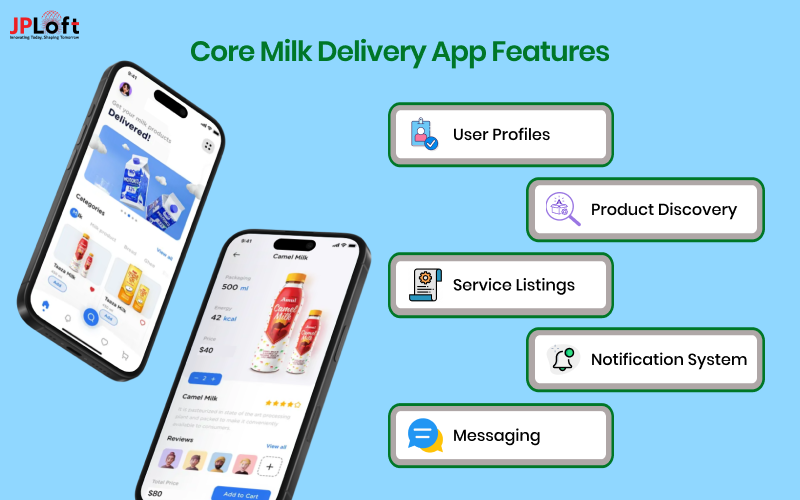
Let’s explore the must-have features that will set your milk delivery app apart.
► User Profiles and Authentication
Every milk delivery app starts with user registration, which includes making a profile and a safe login.
User profiles store important details like contact information, delivery choices, and order history, making each experience unique. Identification methods such as two-factor identification and encryption guarantee that user data stays safe and private.
► Product Discovery and Ordering System
The searching and purchasing process is fundamental to any milk delivery app. Customers may sample various milks, dairy products, and other necessities. They may easily make orders or subscribe to regular delivery.
To make a milk delivery app, it's important to establish an intuitive browsing and purchase procedure that makes shopping for necessities straightforward and hassle-free.
The app often uses algorithms to suggest goods based on user preferences, past sales, and area, keeping the experience new and tailored to the individual.
► Service Listings and Product Details
Milk delivery apps allow service providers (dairies) to show specific product information, such as milk types, prices, nutritional facts, and availability.
For instance, a milk source may offer organic or expensive milk options, allowing customers to make informed decisions based on their needs. The thorough ads ensure openness and help users find exactly what they’re looking for.
► Notification System
Notifications are crucial to informing users of their sales, delivery changes, discounts, and more. Real-time alerts ensure that customers are informed about their delivery status, expected arrival times, and any delays.
Advanced notification settings also allow users to adjust what they want to be informed about, providing a more unique experience.
► Messaging and Communication
Effective contact between users and service providers is important in a milk delivery app. In-app chat allows users to reach out to their milk delivery service for problems like delivery time, product questions, or special requests.
A smooth contact system improves user happiness and helps settle any issues quickly, boosting retention rates. If you’re planning to build a milk delivery app, it’s important to combine these key features to ensure a smooth, efficient, and unique experience.
The development process requires careful planning and execution, making sure each feature is intended to meet customer wants and standards while also giving a safe and easy service.
Why Should You Develop a Milk Delivery App?
Developing a milk delivery app in 2025 presents a great chance to tap into a rapidly growing market with huge potential.
Milk delivery apps have become the best option for customers looking for the ease of having fresh milk and other dairy products brought right to their doorsteps as demand for these services continues to rise.
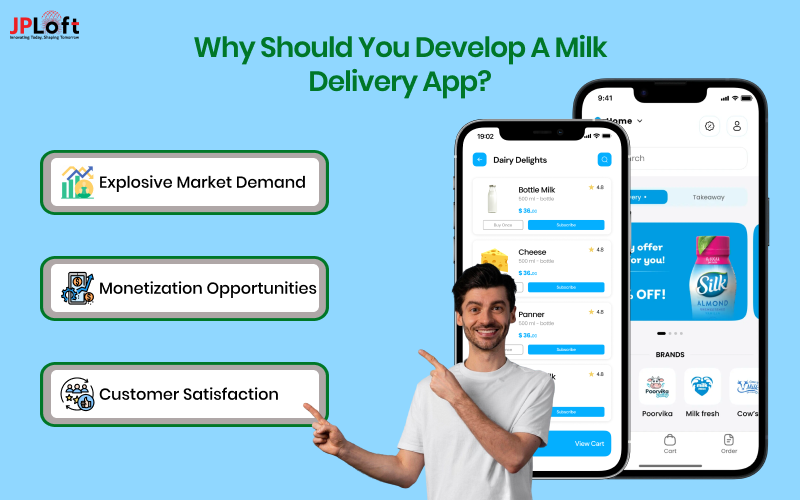
Here’s why now is the right time to start your milk delivery app.
A] Explosive Market Demand
The demand for on-demand app development services is rising, and milk delivery is no exception. More families are looking to apps for the ease of getting fresh milk, healthy dairy products, and other important foods without the trouble of going to the store.
With the rising number of customers who value ease and time-saving solutions, creating a milk delivery app in 2025 puts your business in the right market at the right time.
As more customers move toward mobile services, the chance to interact with a bigger, tech-savvy community is greater than ever.
By giving a milk delivery app, you can meet the rising demand for ease and tap into a market that’s quickly becoming reliant on mobile services.
B] High ROI and Monetization Opportunities
Milk delivery apps offer the possibility for high returns on investment with multiple earning possibilities. From charging delivery fees to offering subscription-based models for regular deliveries, these apps can provide a lucrative platform for earning income.
Additionally, adding paid features like planned orders, priority service, or special sales can create even more income streams. In-app ads, relationships with local farms, and packaged deals are just a few ways to broaden your income.
With the right business plan and revenue strategy, you can build a milk delivery app that not only serves a growing market but also offers substantial financial gains.
C] Convenience and Customer Satisfaction
In today's fast-paced world, consumers choose convenience above anything else. A milk delivery app makes it easier to receive fresh milk and dairy products by enabling users to place orders, monitor deliveries, and make payments right from their smartphones.
By developing a milk delivery app, you provide clients with a simple, dependable, and efficient method to get the dairy products they need. This convenience increases consumer happiness, resulting in improved retention rates and favorable word-of-mouth.
The simplicity of use and convenience of home delivery means that your app stands out in a competitive market, making it a desirable option for clients.
Why This is the Right Time to Build a Milk Delivery App in 2025?
With rising market demand, a high ROI potential, and an emphasis on customer convenience, 2025 presents an excellent chance to create a milk delivery app that meets the evolving expectations of today's on-demand customers.
By embracing the on-demand delivery trend, you can design an app that provides genuine value, satisfies user expectations, and creates long-term revenue. With the proper features, an efficient market strategy, and careful preparation, you can effectively design and launch a milk delivery app.
You may create a successful app that attracts users and thrives in an ever-expanding industry by following a detailed development roadmap and putting client requirements at the forefront.
Step-by-Step Guide to Milk Delivery App Development
Developing a milk delivery app requires careful planning, serious decision-making, and specialized technology skills.
This guide will walk you through everything you need to know to create an on-demand milk delivery app, from initial market study to ongoing help and maintenance after launch.
Here is a step-by-step breakdown of the whole milk delivery app development process in detail.
Step 1: Deep Market Study
The first step to create a milk delivery app is performing a thorough market study. This involves knowing current trends in the milk delivery field, finding customer pain points, and evaluating your rivals.
By studying other popular milk delivery apps, you can spot gaps in the market and find chances to offer something special. Market research helps identify your target audience’s wants, preferences, and the obstacles they face in getting milk and dairy goods.
With this information, you can tailor your app to meet the unique demands of your target customers, ensuring it stands out in a competitive market.
Step 2: Define Your Niche
Once the market research is complete, it's time to describe your area. The milk delivery service market can include fresh milk, pure milk, dairy goods, and more. Deciding whether your app will offer a broad range of goods or focus on a specific area is crucial.
For instance, you could focus exclusively on organic or premium milk choices or provide a general service catering to a variety of dairy goods. Pinpointing your area will help separate your app from rivals and build a strong brand personality that connects with your audience.
Step 3: Decide the Features and Functionalities
Next, determine the core features and functions your app will offer. Essential features for a milk delivery app include service booking, in-app purchases, and customer comments. Advanced features, like membership models, automatic refilling, and live GPS tracking, can enhance user experience and add value.
It’s important to select features based on your target audience’s wants and cash limits. Conducting detailed research at this stage ensures that your app development team knows the scope and needs, setting the basis for a smooth development process.
Step 4: Select the Tech Stack
Choosing the right technology stack is important for ensuring your app works well, grows effectively, and is easy to manage. Frameworks like React Native or Flutter can help you build a cross-platform app that works smoothly on both iOS and Android devices.
Back-end technologies like Node.js and Firebase ensure that your app quickly handles user requests and provides a smooth experience. Selecting a well-suited tech stack will not only support your app's current usefulness but also allow for future updates and features.
Step 5: Choose the Target Platform
Choosing your goal platform is an important choice. Depending on your target and price, you can choose iOS, Android app development, or both. Android tends to reach a larger global audience, while iOS users are often more involved and can produce higher income per user.
If you're looking to launch on both platforms without doubling mobile app development costs, you can opt for cross-platform tools like Flutter to offer an app that works across multiple devices quickly.
Step 6: Find a Reliable Development Partner
Finding a trusted development partner is important for making your milk delivery app plan into reality.
Whether you choose an in-house team, person, or company, make sure the team has experience with making on-demand service apps and knows the special needs of the milk delivery market.
Review their resume, customer comments, and conversation skills to ensure that the app development team is a good fit for your project. A trusted partner, such as Jploft, will help you stay on track with timelines, price, and quality.
Step 7: Create an MVP
Building a Minimum Viable Product (MVP) is the best way to test your app idea in the market. An MVP includes just the important features, such as service ads, booking systems, and payment methods, allowing you to gather useful feedback before investing in a full-fledged app.
Starting with an MVP gives you the chance to test your app’s core abilities and make changes based on real-world user feedback, lowering the risk of building features that don’t meet customer needs.
Step 8: App Development
Once the MVP is proven and better, move on to full-scale app development. This part includes making the full app with all the advanced features and tools you plan to offer, such as custom ideas, analytics, advanced payment systems, and real-time delivery tracking.
Collaborate closely with your development team to ensure that the app is safe, scalable, and user-friendly. The goal is to create a smooth user experience that will encourage users to return to your app for their milk delivery needs. Consider partnering with experts in mobile app development services to achieve this seamlessly.
Step 9: Rigorous Testing
Testing is an important step before starting your app. You must ensure that the app is bug-free, safe, and provides a smooth experience for your users.
Conduct functional testing to verify that all features work as expected, usability testing to assess the user interface, and speed testing to ensure the app can handle high traffic.
Testing in different settings and devices ensures that your app is ready to work smoothly for all users, no matter their smartphone model or location.
Step 10: Prepare for the Launch of the App
Launching your app is an exciting moment, but it requires careful planning. Before releasing your app to app stores, make sure to follow their rules, build an appealing app store listing with relevant keywords, and improve your app’s exposure.
Promote your app through social media, relationships, and email campaigns to build interest and create buzz before the official launch. A well-executed launch plan will help ensure that your app starts with strong user interaction.
Step 11: Support and Maintenance
Ongoing support and maintenance are critical for ensuring that your app runs properly and meets user expectations. Regular performance reviews, platform upgrades, and user input integration will keep your app current and competitive.
App maintenance entails not just correcting problems but also constantly adapting to suit market trends, ensuring that your milk delivery app stays new, dependable, and highly useful for your clients.
Latest Trends in Milk Delivery App
The latest trends in mobile app development for milk delivery apps show the growing impact of cutting-edge technologies and changing customer standards. These trends are changing how customers access and enjoy their milk and dairy products, giving better, more efficient, and customer-centric solutions.
Here are the key trends currently shaping the milk delivery app landscape:
► Integration for Personalization
AI-powered algorithms are becoming a big tool in milk delivery apps. These algorithms can analyze user preferences, past sales, and behavioral trends to provide personalized suggestions, such as giving preferred milk types, special dairy products, or subscription choices.
This not only improves the user experience but also increases participation by making the app better and more attuned to individual needs.
► IoT for Smart Delivery Management
The Internet of Things (IoT) is changing milk delivery services by combining smart gadgets into the delivery process. IoT-enabled apps can watch the quality of milk, handle delivery routes more efficiently, and even predict delivery times in real time.
For example, customers can set up IoT-connected smart fridges that automatically replace milk when supplies run low, adding another layer of ease and efficiency to the service.
► Augmented and Virtual Reality (AR/VR) for Enhanced Experience
AR and VR are starting to find their place in the milk delivery business. For instance, augmented reality could be used for virtual talks where customers can picture the health benefits of different types of milk or view specific information about the source of their milk.
Additionally, AR could help users find and compare different dairy choices based on their preferences, giving a dynamic and interesting experience.
These trends point towards a more clever, safe, and sustainable approach to milk delivery apps.
As technology continues to change, staying ahead of these trends will be crucial for giving a next-level user experience and keeping a competitive edge in the milk delivery market.
Cost to Build a Milk Delivery App
The cost of building a milk delivery app usually runs from $15,000 to $150,000 or more, based on several factors.
Basic apps with core features such as order placement, payment methods, and simple tracking tend to cost on the lower end, while more advanced apps having unique functions, advanced interfaces, and growth choices will push the cost higher.
To provide exact cost figures, it's important to consider things like app complexity, development area, and the tech stack used.
Here's a breakdown of the key factors affecting the development cost of a milk delivery app:
|
Factors |
Effect on Cost |
|
App Complexity |
Simple apps with basic buying and payment features cost less, while apps with advanced features like AI-driven suggestions or IoT integration can raise the price. |
|
Number of Features |
The more features your milk delivery app has, such as contract management, real-time tracking, and eco-friendly delivery choices, the higher the cost. |
|
Development Platform |
Deciding whether to create the app for iOS, Android, or both changes the cost. Cross-platform apps can be more cost-effective, while separate development for each device raises the budget. |
|
UI/UX Design |
Custom, user-friendly designs with a focus on ease of use and smooth encounters may require extra design knowledge, raising costs. |
|
Development Team |
Hiring a skilled and experienced mobile app development team ensures quality but comes at a higher price. Partnering with a respected business or independent pros can affect your budget. |
|
Tech Stack |
Using modern technologies like React Native, Flutter, or Node.js can influence costs based on speed needs and flexibility. |
|
Geographic Location |
Development costs change based on the location of the development team. Developers in the U.S. or Western Europe usually charge more compared to those in areas like Asia or Eastern Europe. |
|
Post-Launch Support |
Ongoing upkeep, changes, and server costs for the app's continued running and growth are important and add to long-term expenses. |
If you’re trying to develop a milk delivery app on a budget, consider making a Minimum Viable Product (MVP) to test the idea with important features first.
Additionally, hiring mobile app developers from areas with cheaper rates can help reduce costs without losing quality.
How to Overcome the Challenges of Milk Delivery App Development
To build a milk delivery app comes with its own set of special difficulties. However, conquering these hurdles ensures a faster development process and a successful, reliable app.
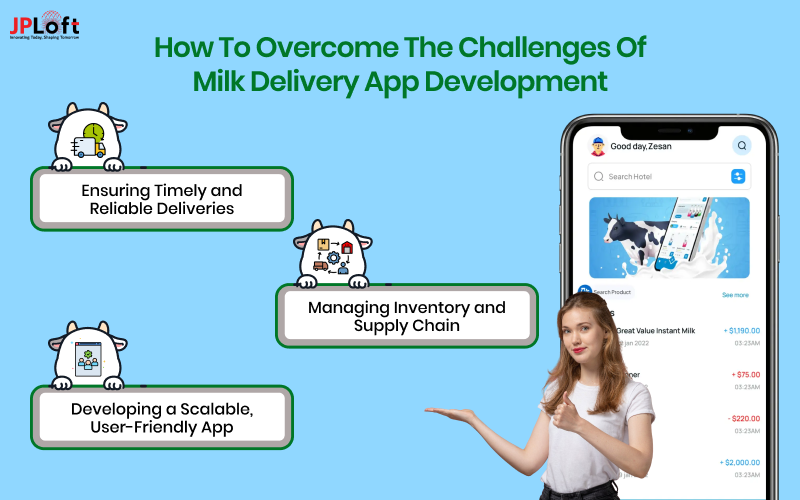
Below are the major problems and their real solutions:
A] Ensuring Timely and Reliable Deliveries
Challenge: Timely supplies are important in a milk delivery service, especially since milk is a fragile product. Delays or failed deliveries can hurt your image and customer trust.
Solution: To avoid delays, build a strong transportation system that includes real-time tracking, improved routes for drivers, and clear contact with clients.
Also, create strict delivery time frames and include backup plans for unavoidable delays, such as weather or traffic problems.
B] Managing Inventory and Supply Chain
Challenge: Managing stocking levels and ensuring a constant supply of fresh milk can be difficult, especially with fluctuations in demand or seasonal changes.
Solution: Implement a prediction analytics system that predicts demand trends based on past data and cycles.
Partner with reliable dairy farms or suppliers and ensure you have backup suppliers for unexpected gaps. Regularly watch supplies and set automatic stock alerts to avoid out-of-stock situations.
C] Developing a Scalable, User-Friendly App
Challenge: Building a scalable app that combines important features like payment methods, locations, and user messages can be complex, especially when ensuring a smooth user experience.
Solution: Work with a skilled development team that specializes in on-demand services and mobile apps. Use a strong tech stack that supports growth and offers smooth performance across iOS and Android. Regularly try and update the app to ensure it’s user-friendly and fast.
By proactively handling these challenges, you can build a milk delivery app that not only meets customer standards but also ensures long-term success in a competitive market.
Following this complete guide to milk delivery app development will help you build a reliable and efficient platform that provides value to both users and businesses.
How to Monetize a Milk Delivery App?
Monetizing a milk delivery app can open up several lines of income, based on your business plan and the value you offer to your customers.
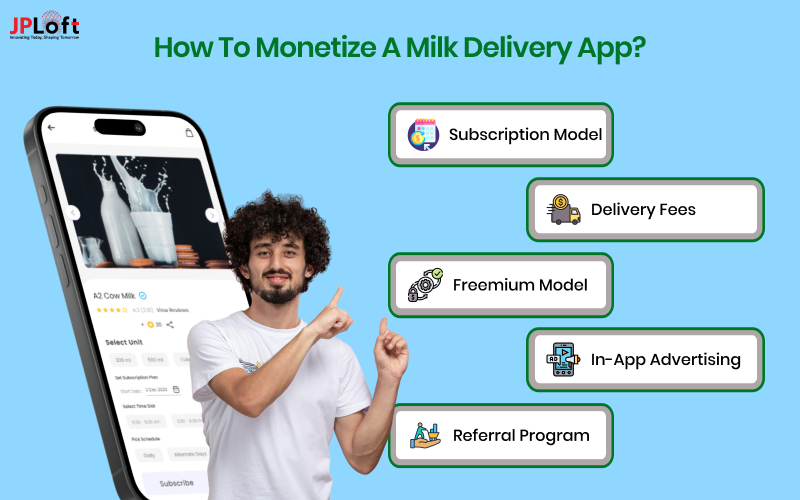
Here are the most popular ways to monetize a milk delivery app:
1. Subscription Model
One of the most reliable ways to sell a milk delivery app is by giving a membership service.
Customers can commit to daily, weekly, or monthly milk supplies at a set price. This plan gives regular and ongoing income, which helps in handling business operations efficiently.
How it works:
-
- Customers choose their chosen delivery regularity and pay in advance.
- You can give different plans based on delivery regularity or amount of milk.
2. Delivery Fees
Charging customers a delivery fee is another simple way to generate income.
You can apply a set delivery fee or base the fee on factors such as delivery distance, delivery time slots, or order size.
How it works:
-
- Every purchase might include a fixed delivery price.
- Fees may vary by geography or client category (for example, premium delivery).
3. Freemium Model
Provide basic delivery services for free or at a low cost, but premium features such as quicker delivery, special deals, or premium customer care are available for an extra fee. This technique helps to recruit a larger client base while profiting via upgrades.
How it works:
-
- Basic delivery is free, but premium features need payment.
- Customers may get extra advantages by subscribing or paying a one-time charge.
4. In-App Advertising
You may collaborate with other companies (for example, health-related items, local eateries, or grocery shops) to show advertisements inside the app. This is a passive income stream in which you receive money depending on the number of times your advertising are shown or clicked.
How it works:
-
- Place targeted adverts throughout your app (for example, in product listings or during the checkout process).
- Partner with local companies to display their advertisements or promotions.
5. Referral Program
Referral programs encourage users to recommend the app to others in return for discounts, awards, or free delivery. This promotes user acquisition and may boost consumer engagement.
How it works:
-
- Provide a referral benefit (e.g., discounts, free delivery) to users who bring friends or family to the service.
- Track using referral links or codes.
By combining one or more of these monetization tactics, you may build a lucrative milk delivery app that provides value to your users. The idea is to adjust your approach to the preferences of your target audience while being flexible as market circumstances change.
Build a Feature-Rich Milk Delivery App with JPLoft
JPLoft specializes in creating cutting-edge milk delivery apps that provide a smooth user experience and tailored services.
As a recognized milk delivery app development company, we prioritize order processing speed, real-time tracking, and secure payment choices to give your clients seamless, trustworthy solutions.
Our skilled team tailors each milk delivery app project to your exact specifications, using agile development processes and following the best industry standards.
One of our significant projects is the MilkMate app, which was created by our professional mobile app developers and demonstrates our dedication to providing creative and bespoke delivery solutions.
Whether you're starting a new milk delivery business or improving an existing one, JPLoft can help you reach your goals.
Ready to create a user-friendly milk delivery app with simplified features and an excellent client experience? Contact us to get started!
Wrapping Up
Developing a milk delivery app is an exciting and lucrative business with vast potential in today’s market. By focusing on important features, user-friendly design, and keeping updated on the latest trends, you can create an app that meets customer wants effectively.
While the development process comes with challenges, knowing these hurdles and how to beat them will ensure a better trip. Whether you're building from the start or seeking expert assistance, focusing on key elements such as smooth operation and a reliable delivery system will help you create a successful milk delivery app.
Don't forget to consider revenue choices to improve your app’s income.
FAQs
The cost of building a milk delivery app can range from $15,000 to $150,000 or more, based on the app's features, style, and complexity. Customizations suited to your business plan and target market will affect the total cost.
Developing a milk delivery app usually takes 3 to 6 months. This relies on the app's difficulty, the features you wish to include, and the development team you choose. Having a thorough plan can simplify the process.
Key features include user registration, membership choices, order tracking, safe payment integration, customer support, push alerts, and delivery management systems.
To stand out, focus on giving unique features such as adjustable delivery plans, real-time tracking, reward programs, targeted suggestions, and a simple user interface. Quality customer service is also important for longevity.
Future trends include the merging of AI for personalized customer experiences, IoT for smart delivery systems, and blockchain for secure transactions. Subscription-based services and eco-friendly packages are also becoming increasingly common.





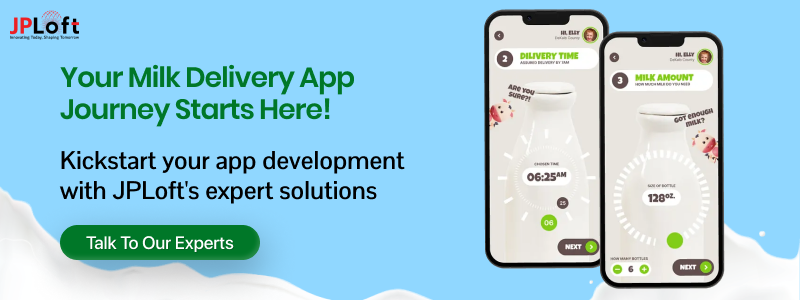
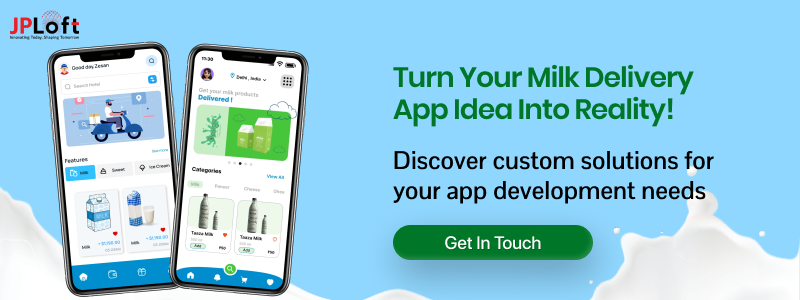
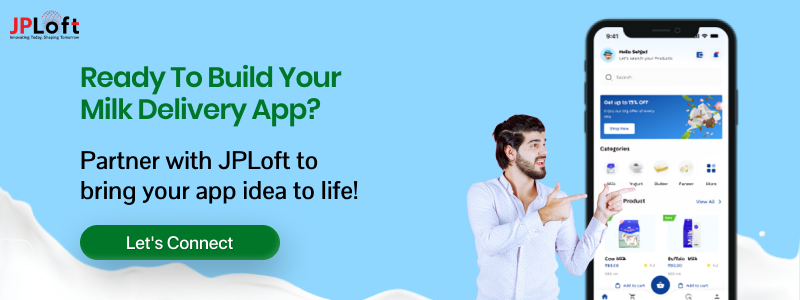

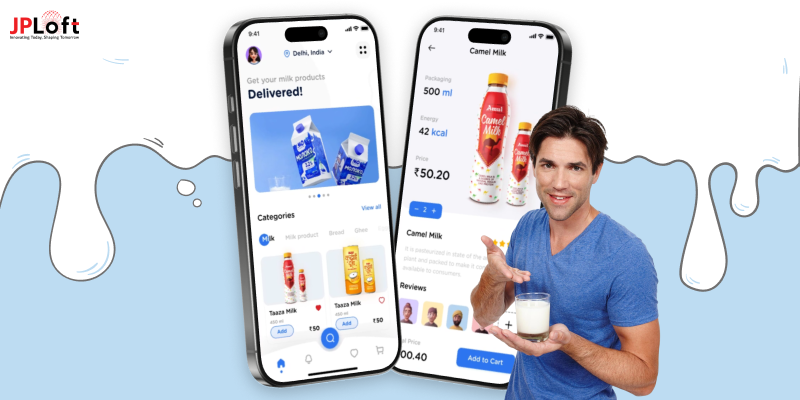
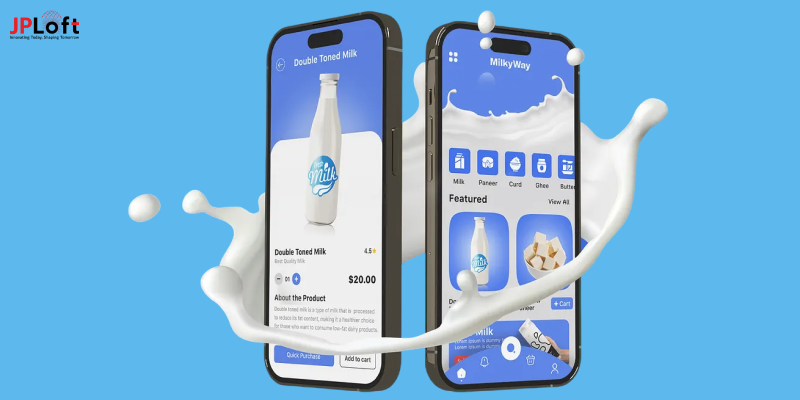
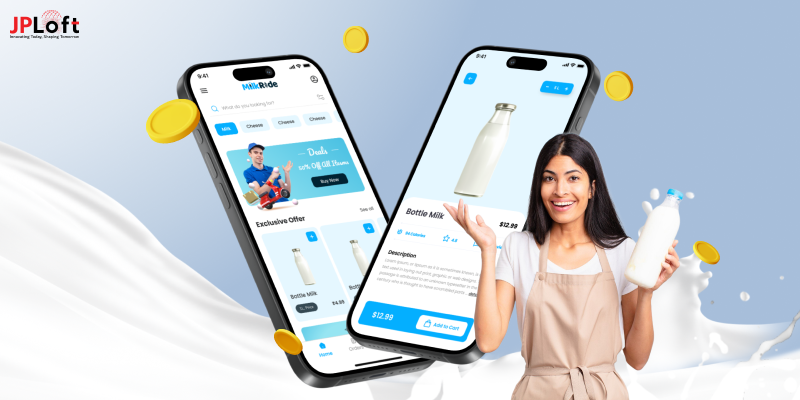



Share this blog